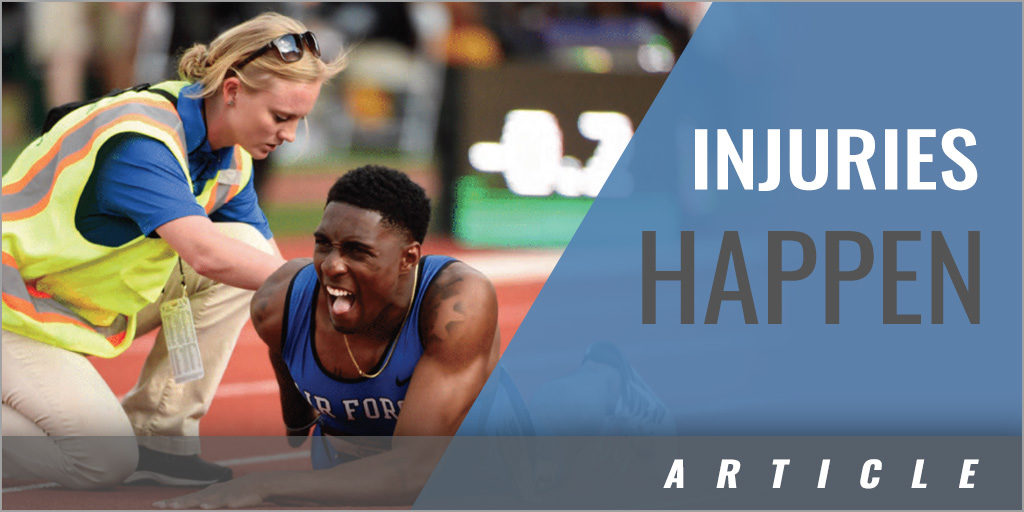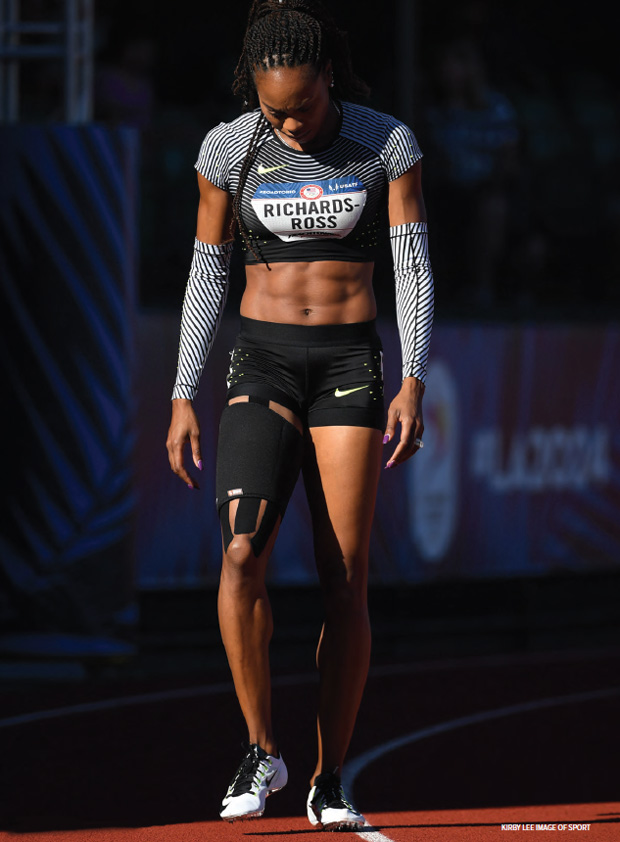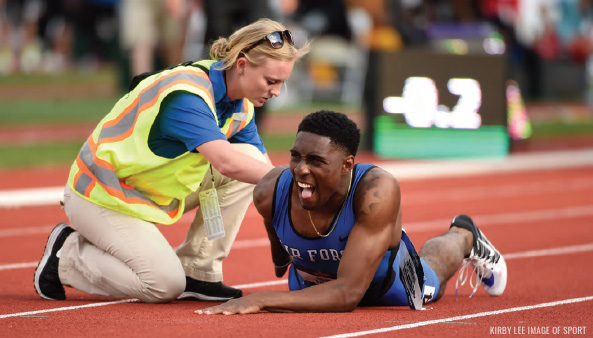|
Originally Published in: Techniques Magazine Provided by: USTFCCCA Injuries Happen. Injury is an inherent part of track and field participation. One study of a NGB's track & field participants, from youth through elite, found that over 60% suffered some sort of injury in a calendar year. Another study evaluated the types and locations of injuries occurring in track and field. The most common injury locations were the leg, thigh and knee, with the most common diagnoses being stress fractures and hamstring strains. A significant number were overuse in nature, and approximately one-third of all the injuries were recurrent. Given these statistics, it's apparent why coaches should develop an understanding of injuries, and maybe more importantly be able to assist in the recovery and rehabilitation process.
Now What? In the case of an acute injury, it is important to make quick decisions about the proper care of the athlete. For this reason, it is recommended that coaches have certifications in both CPR and basic first aid. Depending on the setting or competition venue, there may not be athletic trainers or physicians on site or in close proximity. One must be able to know when to call 911 or when to transport someone immediately for care. It's always best to be overly conservative versus facing the possibility of mismanaging a significant injury and the liability that comes with it. Significant Injuries. The phrase "Check, Call, Care" is an easy way to remember the steps involved in the management of significant or life-threatening injuries. The first step, Check, refers to assessing the scene and the victim. Secondly, Call means calling 911 and starting the emergency response chain. The final step is Care. In this step, with the proper training in CPR and first aid, the responder begins applying their training to the situation. Most importantly, do no further harm. If properly trained, the responder can be an important care giver before the EMTs or responding professionals arrive on the scene. It is also important to know the emergency action plan for the given practice or competition facility and for your employer. Non-Life Threatening Situations. In the case of non-life threatening injuries, the most traditional guideline that has been followed is the RICE method. Rest, Ice, Compression, and Elevation have been the standard of care for acute athletic injuries for years. A recent addition to this acronym has been protection, leading to PRICE. This is definitely useful in dealing with more serious injuries such as fractures or dislocations. These injuries need to be splinted and referred to a doctor immediately. If the injury is manageable without transportation, splinting or referral, then the RICE method is an easy acronym to follow for the first 48-72 hours following injury. Who Should They See? The severity of the injury, the organization of the sports medicine team and other factors, such as insurance constraints, will dictate where the athlete is referred to. In cases of major injury such as fractures, tendon or ligament tears, etc., they need to get care immediately. However, in more common and less severe injuries, these can be treated less urgently and may be managed by a wider variety of professionals. If over time, the injury is not progressing as expected, the opinions of other professionals or specialists should be sought. What Must Be Done? Depending on the injury, severity and the type of affected tissue, the need for imaging or follow up tests will be determined. Often times, in dealing with family practice or convenient care/emergency room physicians, a standard x-ray is all that is ordered. However, outside of a fracture, this is not going to show any tissue other than bony involvement. In instances where the injury is more severe or involved than a 1st degree sprain or strain, or the x-ray is inconclusive, more advanced imaging may be ordered. The type of imaging needed to make a full diagnosis will be dependent on the type of tissue the physician suspects to be injured. MRIs, bone scans, CT scans and diagnostic ultrasound are the most commonly used imaging techniques for athletic injuries. IMAGING AND DIAGNOSIS Imaging Tools MRI. MRI stands for Magnetic Resonance Imaging. MRIs show soft tissue injuries such as tendon, ligament and muscle issues. They can also be used to look at bony injuries such as stress fractures. MRIs use magnetic fields to create cross-sectional pictures of the tissues being examined. There are a few different types of MRIs that doctors can used depending on the tissue being examined and the detail they are looking for. In sports medicine, the most common are traditional MRI and a MRI arthrogram. An arthrogram involves injecting a dye agent into the tissue that then allows for a clearer image to be captured. Bone Scans. Bone scans involve injecting a radioactive material that collects at sites of increased or decreased bone activity such as fracture or stress injuries. A bone scan is a two part test that involves going in for the injection then returning a few hours later for the scan. It does show a full body image, so in instances where bilateral stress injuries are suspected, it can be more efficient than MRIs. CT Scans. Computer tomography (CT) scan is an imaging method that uses x-rays to create cross-sectional pictures of the body. Traditionally, CT scans are mainly used in the sports medicine realm to evaluate fractures or other bony issues. The slices the scan takes between the images are closer together than in an MRI scan, which allows for a clearer image of issues like fracture lines. Diagnostic Ultrasound. Diagnostic Ultrasound is an imaging technique that uses high frequency sound waves to create relatively precise images of structures or tissues. One unique feature is that the diagnostic ultrasound can create dynamic images so that the tissue can be moved under the sound head and you can see the tissue move, versus just a static picture of the tissue. While not widely available, there are an increasing number of physicians in the US who are starting to utilize this imaging tool in their evaluation and care of musculoskeletal issues. Lab Work. If bone health issues, or other contributing factors such as mineral imbalances are suspected, the need for blood or other lab work may be warranted. In these cases, it's important to note that an athlete's normal ranges may be outside of the ranges shown in general populations. An example of this is ferritin. An athlete needs a higher level of blood iron than a non-athlete based on the demands they place on their body. Diagnosis. Following the physical examination and/or the imaging of a specific injury, the diagnosis of the injury should be able to be made. In the case of a unique injury, inability to make a diagnosis or the need for a specialist's opinion, a referral may be made to come to a conclusive diagnosis. Once a diagnosis is made, a treatment plan needs to be established. Treatment Plan. Depending on the injury, a variety of modalities and treatments can be pursued or used to aid in the healing process. It is important that open communication exists between all involved parties so that everyone is aware of all the treatment and various modalities and professionals who are involved in the process. Like building a workout plan, it's important to understand the logic behind the selected modality or treatment, the stimulus it applies to the body, and the body's corresponding reaction to the treatment. The emphasis of the treatment plan is to support and enhance the body's ability to heal. Goals should then be set for each phase of the healing cycle and rehabilitation process. Initial goals should always include managing pain and inflammation and restoring range of motion. Following the accomplishment of these goals, then strength, function, and return to play and competition goals can be established. Psychological Considerations. In an injury situation that is going to require time out of practice or competition, the psychological effect of the injury on the athlete must be considered and addressed. If these effects and issues aren't addressed through the rehab process, the athlete may face fear of re-injury or other issues as they return to the track. Progressions. As with constructing a training plan, putting a treatment plan must include goals and progressions. At times, it's easy for medical professionals to get stuck in a rut in regards to specific therapies and modalities. As goals are achieved, athletes must be progressed and MODALITIES Modalities. There are numerous modalities that can be used in the treatment in athletic injuries. In the last 10 to 20 years, the number of these various modalities has increased greatly. While some of these modalities have extensive research and evidence based guidelines to follow, other modalities have only anecdotal evidence or testimonials to support their usage. TYPES OF MODALITIES Thermal Modalities. The most widely used modalities in Sports Medicine are heat and cold modalities. These modalities are often used due to ease of use and availability. HEAT Heat Therapy. Heat therapy, also known as thermotherapy, is the transfer of heat, through conduction, convection, and/or radiation to tissues of the body. This can be achieved through heat packs, hot whirlpools and a wide variety of other heating modalities. EFFECTS OF HEAT THERAPY
COLD Cold Therapy. Cold therapy, also known as cryotherapy, is most often achieved through ice packs, ice cups, or cold whirl-pools. EFFECTS OF COLD THERAPY
Hydrotherapy. Besides the thermal properties of cold or hot whirlpools, there are other benefits of using water as a treatment modality. The hydrostatic pressure the water exerts on the body does provide some beneficial effects on inflammation, healing and recovery. Water can also be used to unload an athlete due to the buoyancy it provides during the rehabilitation process. Electrical Muscle Stimulation. There are a very wide variety of modality machines that can fall under the blanket term of electrical muscle stim. These transcutaneous electrical stimulation modalities are frequently used in athletic training rooms and sports medicine clinics. However, there is often confusion based on a variety of terms for similar machines and practices, as well as the purpose of the actual treatments. Terminology such as TENS, Neuromuscular electrical nerve stimulation (NMES), and electrical muscle stimulation (EMS or E-Stim) is frequently used interchangeably and without proper context. Regardless of the terminology, these units use alternating current (AC), direct current (DC), or pulsitile currents through electrodes or probes on the skin to create a desired physiological response. Most frequently, the actual parameters of the treatment are based on the current used, the waveform, pulse duration, frequency and current modulation. Most muscle stim treatments are either focused on modification of pain or muscle contraction and nerve stimulation. There is a subset of electrical stim called microcurrent that, in theory, addresses tissue healing at a more cellular level. While widely available and frequently used, these modalities can be quite beneficial, but it is important that they are used with a purpose and plan. Ultrasound. Therapeutic ultrasound can be used to treat a wide range of soft-tissue injuries. Due to the mechanical properties and the forces of sound waves, ultrasound is mainly used to address soft-tissue injuries. It is mainly used for its thermal and non-thermal effects. The thermal effects include collagen extensibility, decrease in joint stiffness, reduced muscle spasm, increased blood flow and modulation of pain. The non-thermal effects include increased fibroblast activity, tissue regeneration, decreased inflammation and increased soft-tissue repair. The treatment parameters of the treatment are based on the frequency, duration, intensity and desired physiological response. While widely used and beneficial, much like electronic muscle stimulation, these treatment modalities should be used with a plan and purpose. Iontophoresis and Phonophoresis. Phonophoresis and Iontophoresis use either electrical or sound waves to push medication into a tissue. Iontophoresis uses electrical current to drive a charged ion of medication into a tissue. Phonophoresis uses sound waves to push the medication into the tissue. Most frequently, these applications are used for anti-inflammatories or analgesic medications. The use of these modalities can be quite effective, but prudent decisions about the use of anti-inflammatory or other medications need to be made in relation to the stage of the healing process. Intermittent Compression Modalities. One modality that is seeing increase in use is intermittent compression. Mainly used to treat post-injury edema, these units are also being used as a recovery modality. The three parameters that are adjusted are the inflation pressure, on/off time sequence, and total treatment times. One of the reasons for the increase in the use of these modalities is the increasing concerns of use of anti-inflammatories and their effects on the healing process. Laser. An emerging field in modalities is the use of laser based treatments. Mainly using low level lasers, also known as cold lasers, or other forms of light-emitting diodes, these devices are used to treat a variety of medical conditions. Parameters of treatment vary based on the individual unit and manufacturer. Currently, a lot of the evidence for their use is anecdotal, but there is a growing amount of research into their efficacy and the physiological properties involved in their use in tissue healing. Therapy and Soft Tissue Work. Besides modality based treatments, there are various other soft tissue therapy options. Depending on the type of injury and tissue involved, there are numerous techniques and approaches for treating or performing therapy on the injured tissue or body. In some instances, these therapies are limited to specific licensed and trained professionals. Others are taught in clinics and conferences or spread through hands-on training or peer-to-peer teaching and discussions. It is important to interview the therapists before consenting to treatment to establish their understanding and experience of the treatment being provided and their understanding of the sport and athletic demands on the body. Massage. Massage is the mechanical stimulation of soft-tissue via rhythmically applied pressure and stretching. There are a wide variety of techniques, styles and approaches to its application in the sports world. It is used for its reflexive, mechanical and psychological effects on the athlete. These effects include decreased pain, increased blood flow, increased lymphatic flow, decreased muscle tension, soft-tissue mobilization, and many others. Active Release Therapy. Also known as ART in the therapy world, active release therapy involves a movement based therapy system to address soft-tissue restrictions, adhesions and other issues. Typically, movement is used to produce relaxation using agonist-antagonist muscle reflexes, while manual pressure is used to eliminate adhesions and restrictions. ART is a patented technique that is taught in symposiums that teach and certify the practitioners in over 500 protocols or movements addressing the various tissues and structures of the human body.
IASTM. IASTM stands for Instrument Assisted Soft Tissue Mobilization. A variety of tools and techniques fall into this category including Graston, Gua Sha, ASTYM, fibroblaster, the FAT Tool, SASTYM, etc. As the acronym alludes, the purpose of these techniques and tools is to mobilize soft-tissue. These treatments attempt to break down adhesions and scar tissue through mechanical force, as well as cause physiological responses to decrease soft-tissue tension and spasm. A healthy inflammatory response is created and allows the body to heal the tissue. There are a wide-variety of training and certification methods ranging from no-training required to more extensive seminars and conferences. In selecting this treatment, the main objective is selecting the practitioner who uses the technique and assessing their competency and experience in using the technique or tool and its application in the sport and/or injury or issue. Myofascial Release. Myofascial release therapy involves a variety of specific styles and techniques. These techniques often use traction and twisting strokes that are meant to stimulate the fascia and other layers of soft-tissue to release and lengthen. Dry Needling. A growing field in physical therapy and athletic training is dry needling. Similar to acupuncture, dry needling involves placing a filament needle into the soft-tissue to create a physiological response. Sometimes referred to as westernized acupuncture, it is frequently used to treat trigger points, soft-tissue conditions, and pain issues. Applied Kinesiology. Applied kinesiology therapies involve manual muscle testing, which directs the therapist to tissue or the root cause of the pain or dysfunction the athlete is experiencing. Sometimes, these tests are used to evaluate not only the structural factors but also chemical and energy field dysfunctions. There are various training and realms of practice involving Applied Kinesiology, so it is useful to interview and assess the therapist's competency before consenting to treatment. Autologous Injections. While not truly a hands on therapy, there is growing interest in use of legal, autologous injections to treat musculoskeletal injuries and issues. Most popular is the use of Platelet-rich plasma (PRP) in the treatment of muscle and tendon injuries. PRP involves collecting blood from the athlete, centrifuging it down to separate the plasma, and then injecting the platelet-rich plasma back into the injury site of the athlete. The theory behind these type of injections is that the substances that are injected back into the athlete either help the body speed up the healing process by giving it more of the substrates it needs, or by restarting up the healing process in tissue that has been chronically injured. If these injections are pursued, it is best to have an experienced, ethical physician administer them under diagnostic ultrasound guidance. There is ongoing research on the use of administering stem cells or other autologous tissues, substrates or enzymes for healing purposes. Currently, other than PRP, these other injections are not clinically approved in the United States and have not been allowed by USADA or WADA. ACKNOWLEDGEMENTS: THE INJURY MANAGEMENT FOR THE TRACK AND FIELD COACH COURSE CURRICULUM OF THE TRACK AND FIELD ACADEMY WAS CONCEIVED AND WRITTEN BY RANDY BALLARD, WITH ASSISTANCE OF DUSTIN WILLIAMS IN THE FALL OF 2012, WITH THE EDITORIAL ASSISTANCE OF BOO SCHEXNAYDER. |








